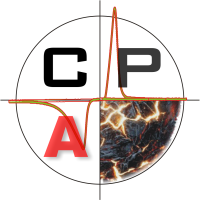
Journal of
Corrosion and Anticorrosion Protection


 Volume IV, Issue 1, 2009
Volume IV, Issue 1, 2009
 Home
Home------------------------------
 About
Us
About
Us ------------------------------
 Authors Guide
Authors Guide------------------------------
 Subscription
Subscription-----------------------------
 News
News-----------------------------
 Contact
Us
Contact
UsContent



Liana ANICĂI , A.
FLOREA, M. DUŢU, T. VIŞAN
, A.
FLOREA, M. DUŢU, T. VIŞAN
Corrosion behaviour of composite films based on polypyrrole
applied onto aluminum substrates
Abstract: Some experimental results regarding electrodeposition of polypyrrole films doped with phosphomolybdate anions onto Al substrates are presented. The formed films according to the proposed procedure exhibited a very good adherence on the metallic substrate, with a uniform black color, showing classical cauliflower morphology, more dense and ordered in the presence of Tiron, according to SEM and AFM investigations. EDX analysis revealed the presence of doping anion within polypyrrole layer. The presence of Tiron lowers significantly the deposition potential of polypyrrole, acting as mediator that is in accordance with other literature reports. Based on various corrosion tests involving potentiodynamic measurements and EIS spectra during continuous immersion in NaCl 0.5 M solution as well as salt mist exposure, a moderate corrosion protection of polypyrrole based layers onto Al has been evidenced. However, the incorporation of phosphomolybdate anion proved to have a beneficial influence on the protective characteristics.



Marioara Abrudeanu  , Alice
Dinu
, Alice
Dinu , Maria
Petrescu
, Maria
Petrescu
Stress Corrosion Cracking Behavior of Oxidized ZIRCALOY-4
Claddings
Abstract: With the aim to study the Zircaloy-4 Stress Corrosion Cracking (SCC) susceptibility several samples with different levels of thickness of the oxide layer (2.7µm, 4.5µm and 8µm) were prepared using a thermo-analyzer SETARAM SETSYS EVOLUTION 24. The mode of stressing chosen in this work was according to the C-ring method. In this case, the value of the stress was estimated at 480 MPa using the ANSYS code. The oxidized C-rings were tested by electrochemical methods in KI 0.55g/l + LiOH solution (pH=10.5) at 850C. The metallographic method emphasized some pits and incipient cracks on the inner surface of the tested samples. The number of pits increases with the oxide thickness. Only for the samples having an oxide layer thickness of 8µm the cracking of the external oxide layer consisting of monoclinic zirconium oxide was put in evidence. For this reason, in the tetragonal oxide under-layer (formed at the zirconium matrix – zirconium oxide interface) micro stress appears to be a fact that generates breakage of this internal under-layer. In this way, the corrosive agent may attack the zirconium alloy, leading to SCC initiation.



Gabriela Elena BADEA  , Liana
MARIN
, Liana
MARIN , Petru CREŢ
, Petru CREŢ
Corrosion and passivation behaviour of the 18Cr-10Ni stainless
steel in acetic acid solutions
Abstract: Anodic and cathodic potentiostatic polarisation curves on the 18Cr-10Ni stainless steel electrodes in aqueous acetic acid solutions of various concentrations (1.67; 3.33; 6.67; 10; 13.33 M) have been recorded at the room temperature in the presence and absence of the dissolved oxygen. In deaerated solutions, the anodic curves of the 18Cr-10Ni stainless steel show an active region of potential, which is characterised by a peak current, while in presence of the dissolved oxygen the anodic curves indicate spontaneous passivity. In the transpassive region appears another current peak of which value increases linear with acetic acid concentration, pleading for the direct electrochemical oxidation of this without evolution of oxygen. The corrosion and passivation electrochemical parameters were evaluated as function of acetic acid concentration. The corrosion current, in deaerated solutions decreases with acetic acid concentration, being in accord with decrease of their conductivity.



Vladimir PARŞUTIN , Emil
PASINCOVSCHY, Vasile AGAFII, Alexandr COVALI
, Emil
PASINCOVSCHY, Vasile AGAFII, Alexandr COVALI
Methods of corrosion resistance increasing of Iron-based
electroplates
Abstract: It were studied two methods of increasing the corrosion resistance of iron-base electroplates: alloying the electroplates with copper, and through the thermochemical treatment of the electroplates. It was established that alloying the iron coatings with copper conducts to changes in the surfaces morphology, physicomechanical, corrosion and electrochemical properties. The corrosion tests have shown that samples, coated with the iron-copper alloy, corrode in the NaCl solution by ~ 1.4, but in 0.05 M solution of Na2SO4 – by ~ 2 times slowly than with the iron coatings. It is determined that at the nitration of iron coating the obtained conversion layer is less porous and provides a higher corrosion resistance. This is confirmed through he fact that corrosion potential moves in positive direction with 0.815 V in comparison with the 45 steel, which wasn’t exposed to the thermal treatment, and with 0.448 V in comparison with the 45 steel, nitrided in the same conditions as the electroplate. Accordingly, the currents of anodic dissolution decrease with 3 and 4-5 orders.



 Year
Year
|2009||2008|
|2007|
|2006|
Revista de Coroziune si Protectie Anticoroziva este editata de S.C. BETAK S.A. Bistrita,
in colaborare cu Universitatea Tehnica din Cluj-Napoca